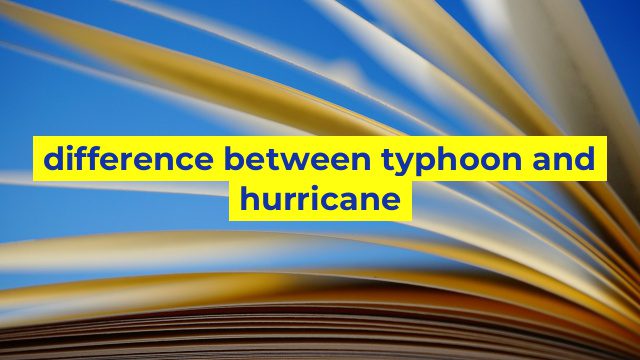What’s the Difference Between Typhoon and Hurricane?
Typhoons and Hurricanes: A Quick Overview
The planet earth is home to many natural disasters that have claimed millions of lives over the years. Among these disasters are typhoons and hurricanes, which can bring about severe damage to properties, loss of lives, and destruction of infrastructures. However, despite the similarities in terms of their impact, typhoons and hurricanes are distinct from one another.
Typhoons are tropical storms that usually form in the northwestern Pacific Ocean near the equator. Japan is mostly affected by typhoons, and they usually occur between May and October. Typhoons are known for their circular wind pattern that can reach up to 74 mph with gusts as high as 150 mph. On the other hand, hurricanes are tropical storms that typically form in the Atlantic Ocean near the equator. They usually occur between June to November and affect the Caribbean, Gulf of Mexico, and Southern United States.
Intensity
Typhoons are known to be slightly more intense than hurricanes. According to National Oceanic and Atmospheric Administration (NOAA), the wind speed in a typhoon can reach up to 174 mph, while in a hurricane, the wind speed generally ranges between 74-110 mph.
Categorization
Both typhoons and hurricanes are categorized according to their intensity. The Saffir-Simpson Hurricane Wind Scale (SSHWS) is used to categorize hurricanes, while the typhoon intensity scale or the Beaufort scale is used to categorize typhoons. Hurricanes have five categories, starting from Category 1, which is the least severe, to Category 5, which is the most violent. Typhoons, on the other hand, are classified into four levels or categories.
Location
Another significant difference between typhoons and hurricanes is their location. Typhoons primarily occur in the northwestern Pacific Ocean, while hurricanes occur in the Atlantic Ocean and the Pacific Ocean.
Naming Mechanism
Hurricanes and typhoons are also named differently, based on their location. Hurricanes are named by the National Hurricane Center, which provides a list of names for the years. In contrast, typhoons are named by the designated meteorological agency for each participating country in the region.
Conclusion
In conclusion, although typhoons and hurricanes share some similarities, such as their nature as tropical storms, there are significant differences between the two in terms of their intensity, categorization, location, and naming mechanism. Understanding these differences can help us better prepare for these natural disasters and better protect ourselves and our properties.
Table difference between typhoon and hurricane
| Typhoon | Hurricane | |
|---|---|---|
| Origin | Northwest Pacific Ocean | Atlantic Ocean or eastern Pacific Ocean |
| Wind speed | 118 km/h or higher | 119 km/h or higher |
| Naming | Named by Japan Meteorological Agency | Named by National Hurricane Center |
| Frequency | About 26 per year | About 10 per year |
| Typical season | June to December | June to November |

